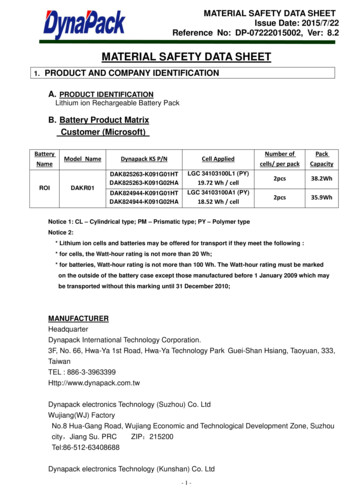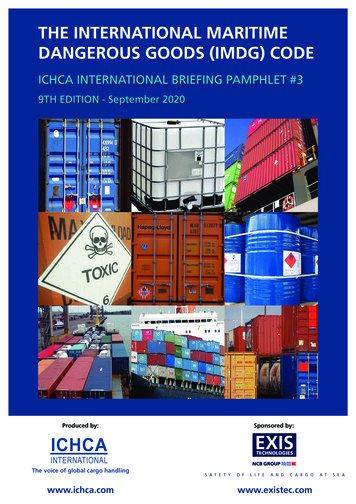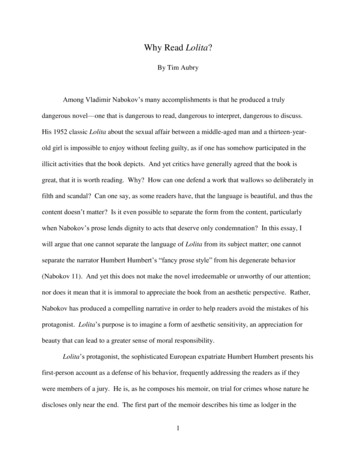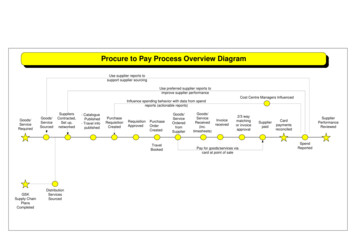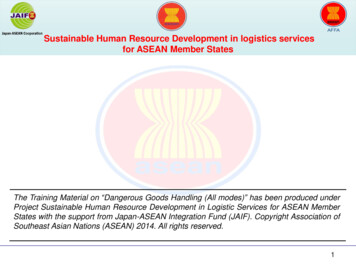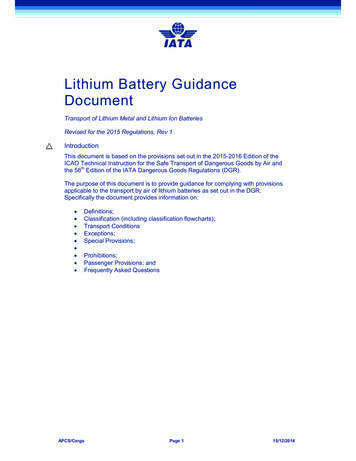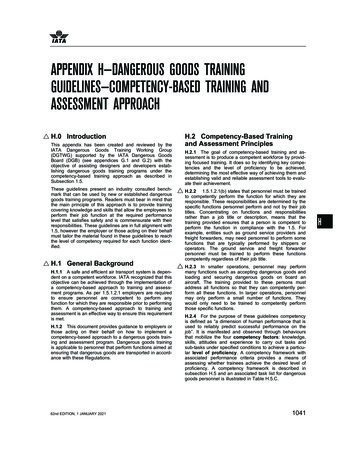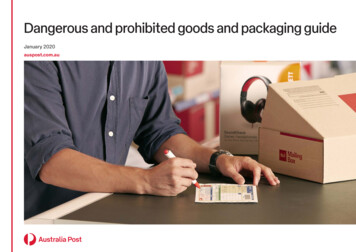
Transcription
Dangerous and prohibited goods and packaging guideJanuary 2020auspost.com.au
Dangerous and prohibited goods and packaging guide – January 2020 Australia Post headquartersGPO Box 1777MELBOURNE VIC 3001Dangerous and prohibited goodsand packaging guide January 2020 PurposeThe Dangerous and prohibited goods and packaging guide contains the standardsof the Australian Postal Corporation regarding contents of articles that can andcannot be excepted by both Australia Post and the conditions, regulatory andlegislative requirements for posting and processing for various articles. This guideis revised and published periodically. Terms and Conditions of serviceUnder the Australian Postal Corporation Act 1989, the Board of the AustralianPostal Corporation determines the terms and conditions that apply to postalservices. Terms and conditions are contained in the Australia Post Termsand Conditions (APT&C) and Determination of Postage Charges (RatesDetermination), available on our website at auspost.com.au/terms. DisclaimerAlthough Australia Post has made every effort to ensure accuracy of the contentsof this guide at the time of publication, Australia Post makes no warranty,guarantee or representation regarding the correctness, completeness, reliability,suitability or accuracy of the content. The information in this guide may berevised at any time and services may be modified, added to or withdrawn withoutnotice. Up-to-date information is available from any Post Office or telephone13 POST (13 7678). Subject to the Australian Consumer Law, Australia Post shallnot be liable to any person for any loss or damage of any kind whatsoever arisingfrom any errors or omissions in this guide or from reliance placed upon all or anypart of the contents of this guide. InstructionsThe Dangerous and prohibited goods and packaging guide contains references toother guides in the series. These are listed below and available for download fromauspost.com.au. Domestic parcels guide (8833732) General products and services guide (8837578) International mail services guide (8833730) Letter products and services guide (8833731). 1
Dangerous and prohibited goods and packaging guide – January 2020 2Table of contentsD4.4 – Items subject to bio-security approvalD4.5 – Native floraD4.6 – Countries subject to United Nations sanctionD4.7 – Military goodsD4.8 – Sporting firearmsD4.9 – Articles sent to more than one personD4.10 – Samples intended to evade CustomsD4.11 – Perishable articlesD4.12 – ValuablesD4.13 – Articles more than A 2,000 in valueD4.14 – Physically offensive articles in the postHow to use this guideSection 1 – Quick reference to common prohibited or restricted articlesSection 2 – Dangerous goods prohibited / permitted in postal servicesD2.0 – General principlesPurpose; Dangerous goods – definition; Dangerous goods carried under contractD2.1 – Class 1 – ExplosivesD2.2 – Class 2 – Gases (includes aerosols)Flammable gas; Non-flammable, non-toxic gases; Toxic gasesD2.3 – Class 3 – Flammable liquidsAlcoholic beveragesD2.4 – Class 4 – Flammable solids; Substances liable to spontaneouscombustion; Substances which in contact with water emit flammable gasesSection 5 – Interstate prohibitions and restrictionsD5.0 – General principlesInterstate movement of plants, fruit and vegetables; Fruit fly exclusion zone;Interstate movement of firearmsFlammable solids; Substances liable to spontaneous combustion;Substances which in contact with water emit flammable gasesD5.1 – Interstate quarantine regulationsOxidising substances; Organic peroxidesD5.2 – Firearms, weapons and ammunitionD2.5 – Class 5 – Oxidising substances and organic peroxidesD2.6 – Class 6 – Toxic and infectious substancesToxic (poisonous) substances; Infectious substances; Exceptions to prohibitionsD2.7 – Class 7 – Radioactive materialsD2.8 – Class 8 – CorrosivesD2.9 – Class 9 – MiscellaneousAviation regulated solid or liquid; Magnetised materials; Legally dangerous;Miscellaneous articles and substances; Lithium batteriesSection 3 – Other goods prohibited or restricted in postal servicesD3.0 – General principlesD3.1 – Possession or carriage prohibited by lawD3.2 – Banknotes and coinsD3.3 – BullionD3.4 – LiquidsD3.5 – Live animalsD3.6 – Narcotic substancesD3.7 – Pastes, powders and tabletsD3.8 – Perishable foodstuffsD3.9 – Physically offensive articlesD3.10 – Sharp and pointed articlesD3.11 – Unsolicited indecent or offensive materialSection 4 – Goods prohibited or restricted in International PostD4.0 – General principles and exceptionsD4.1 – Prohibitions and restrictions by countryD4.2 – National heritage itemsD4.3 – Drugs and pharmaceutical productsNarcotic, psychotropic and other substances; Prescription drugs;Poisonous analytical reference samples from overseasNew South Wales and ACT; Victoria; Queensland; South Australia; Western Australia;Tasmania; Northern TerritoryMovement of firearms – relevant legislation; Ammunition;Firearms / weapons information contactsSection 6 – Import prohibitions and restrictionsD6.0 – General principles – Customs prohibitionsD6.1 – Approving agencies for specific goodsSection 7 – RemailD7.0 – General principlesD7.1 – Large postings abroad by Australian residentsD7.2 – Postings abroad by a non-resident of the countrySection 8 – Articles that Australia Post may refuse to carryD8.0 – General principlesD8.1 – Dimensions or mass of parcelsMaximum weight; Maximum length; Maximum cubic dimension in domestic post;Maximum girth in international post; Minimum sizeD8.2 – Postage stamps and postage meter impressionsD8.3 – Words or symbols likely to delay or misdirectD8.4 – Envelopes or wrappingsD8.5 – AddressingSection 9 – Sender’s responsibility – Acts and regulationsD9.0 – General principlesD9.1 – Sender’s responsibility for dangerous goodsDeclaration; Form of declaration; Contract parcelsD9.2 – Actions by Australia PostAviation Security and Dangerous Goods Declaration not made;Dangerous, prohibited or suspicious articles in the post;Physically offensive articles in the post; Crimes Act 1914 and Criminal Code Act 1995;Australian Postal Corporation Act 1989
Dangerous and prohibited goods and packaging guide – January 2020 Section 10 – Preparation and packagingD10.0 – General principlesD10.1 – Animals, liveBees, leeches and silkworms;European honey bees, parasites and destroyers of noxious insects; Packing and labelling;Mailing guide for live animalsD10.2 – BatteriesWet cell batteries; Dry cell batteries (non-lithium batteries); Lithium batteries or cellsD10.3 – Infectious substancesInfectious substances including biological products, cultures, medical waste and patientspecimens; Non-infectious substances including biological products, medical waste andpatient specimens; Responsibility of sender; Restrictions in domestic post; Prohibited inthe international post; Packaging – infectious substances; Packaging – Biologicalsubstances, Category B; Charges – infectious substances; Quantities; Mailing guide –Category B infectious substances domestic post only; Mailing guide – exempt patientspecimens; Packaging non-infectious (patient specimens)D10.4 – FilmsD10.5 – Foodstuffs, perishableD10.6 – Fragile itemsGeneral considerations; Glass, crockery, cameras, electronic equipment;Pictures, maps, charts, calendarsD10.7 – Fish, poultry, meat and gameD10.8 – Fruit and vegetablesD10.9 – Heavy itemsD10.10 – LiquidsD10.11 – Long itemsD10.12 – Magnetic tapes and discsD10.13 – Pastes, powders and tabletsPastes that easily liquefy; Pastes that do not easily liquefy; Dry non-colouring powders;Dry colouring powders; TabletsD10.14 – Poisons (toxins), drugs and medicinesLabelling requirements for poisons; Therapeutic drugs and medicines lodged in the post;Mailing guide – poisons, including drugs and medicinesD10.15 – Sharp itemsD10.16 – Suitcases and similar itemsD10.17 – Valuable itemsJewellery and coinsSection 11 – IndexAppendix – Items to watch out for 3
Dangerous and prohibited goods and packaging guide – January 2020 How to use this guideThis guide contains detailed reference material about goods that Australia Postprohibits and the special packaging requirements for restricted goods.We have tried to avoid unnecessary duplication. This has meant a certain amountof cross-referencing which can be frustrating if you want facts quickly. To help yougo directly to the right place, set out below are the most common questions andthe quick way to find the right answers.How do I quicklyfind if a commonitem is prohibited?Section 1 has a list of common prohibited items, with across-reference to the appropriate regulation.Where do I finddefinitions ofprohibited goods?Section 2 has definitions of prohibited goods accordingto their International Air Transport Association dangerousgoods classification.Section 3 has definitions of other goods prohibited orrestricted by Australia Post.Are there specialneeds forinternational andinterstate mail?Section 4 has international prohibitions and restrictions.Refer also to the online guide atauspost.com.au/international for the countries servedand their specific conditions and limitations.Section 5 has interstate prohibitions and restrictionsother than dangerous goods.Section 6 has import restrictions and prohibitions.Can Australia Post Section 7 has the Remail regulations.refuse an article for Section 8 covers other articles that Australia Post mayreasons other than refuse to carry.its contents?What are the legalimplications ofsending prohibitedgoods?Section 9 has the sender’s responsibility for domesticand International Post. It also explains what actionsAustralia Post may take according to law.How should I pack,label and markrestricted goods?Section 10 has the provisions that apply to thepreparation and packaging of all mail.What if I have other Check:queries? the Table of contents at the front of the guide the Index at the back of the guide.If you cannot find what you need, telephone13 POST (13 7678). 4
Dangerous and prohibited goods and packaging guide – January 2020 Section 1 – Quick reference to 5common prohibited or restricted articlesSection 1 – Quick reference to common prohibitedor restricted articlesArticle or substanceClassification or commentBlood and its componentsClass 6 – Infectious substances unlesscarried and packed as in D10.3.BromatesClass 5 – Oxidising agentsBullionProhibited. Refer to D3.3.ButaneClass 2 – Flammable gasCamping stores containingflammable gasClass 2 – Flammable gasCarbon dioxide and ethylene oxidemixturesClass 2 – Toxic gasCarbon dioxide, solid (dry ice)Class 9 – Miscellaneous, except whenused as specified in D10.3.Cellulose nitrate productsClass 4 – Flammable solidsChemical ammunitionClass 6 – Toxic substancesChemical kitsClass 9 – MiscellaneousChloratesClass 5 – Oxidising agentsChlorineClass 2 – Toxic gasCigarette lighters containingflammable gasClass 2 – Flammable gasCleaning compounds, flammableClass 3 – Flammable liquidsCleaning liquids, corrosiveClass 8 – CorrosivesClinical wasteClass 6 – Infectious substancesSection 1 – Quick reference to common prohibited or restricted articlesThe following is a list of some common articles and substances prohibitedor restricted in all or some Australia Post services. The list includes, whereappropriate, a reference to the appropriate International Air Transport Association(IATA) dangerous goods classification.Article or substanceClassification or commentA 2,000 or more in valueRestricted in International Post.Refer to D4.13.AcetyleneClass 2 – Flammable gasAerosolsClass 2 – GasesAlcoholClass 3 – Flammable liquids, exceptalcoholic beverages complying withD2.3.1 and D10.10.AmmunitionClass 1 – ExplosivesAnimals, liveProhibited with exceptions. Refer toD3.5.Anti-knock motor fuel additiveClass 6 – Toxic substancesArsenicClass 6 – Toxic substancesAsbestosClass 9 – Aviation regulated solid orliquidAutomobile parts, someClass 9 – Magnetised materialsBacteriaClass 6 – Infectious substancesDetonatorsClass 1 – ExplosivesBanknotesDomestic Registered Post only.Refer to D3.2.Disinfectants, permanganateClass 5 – Oxidising agentsDrugsClass 6 – Toxic substances, unlesspacked and carried in accordance withD10.14.For International Post, refer to D4.3.Engine starting fluidClass 3 – Flammable liquidsEngines, internal combustionClass 9 – MiscellaneousExcretaClass 6 – Infectious substancesFencing, metal, someClass 9 – Magnetised materialsFibreglass repair kitsClass 5 – Organic peroxidesFilm, cellulose nitrateClass 4 – Flammable solidsFire extinguishers containingcompressed or liquefied gasClass 2 – Non-flammable, non-toxicgasBatteries, car (or any wet cell battery) Class 8 – CorrosivesBatteries, dry cellProhibited unless packed as in D10.2.Batteries, lithiumProhibited unless packed as in D10.2.3.BenzeneClass 3 – Flammable liquidsInfectious substances includingProhibited unless carried and packedbiological products, cultures, medical as in D10.3.waste and patient specimensBlades, surgical, usedClass 6 – Infectious substancesBlasting capsClass 1 – ExplosivesBleaching agents, permanganateClass 5 – Oxidising agentsContinued on next page
Dangerous and prohibited goods and packaging guide – January 2020 Section 1 – Quick reference to 6common prohibited or restricted articlesArticle or substanceClassification or commentArticle or substanceClassification or commentFirearmsFor Domestic Post, refer to D5.2.For International Post, refer to D4.7 andD4.8.MagnetsClass 9 – Magnetised materialsMatches of all kindsClass 4 – Flammable solidsMeatRefer to D10.7 for packingrequirements.MedicinesClass 6 – Toxic substances, unlesspacked and carried in accordance withD10.14.For International Post, refer to D4.3.FireworksClass 1 – ExplosivesFishRefer to D10.7 for packingrequirements.FlaresClass 1 – ExplosivesFoodstuff, perishableProhibited unless packed as in D10.5.Fragile itemsRefer to D10.6 for packingrequirements.FruitRefer to D10.8 for packingrequirements.Mercury, mercury compounds orClass 8 – Corrosivesmercury in manufactured items, suchas thermometersMustard gasClass 6 – Toxic substancesNarcoticsProhibited. Refer to D3.6.Needles, surgical, usedClass 6 – Infectious substancesClass 2 – Non-flammable, non-toxicgasFungiClass 6 – Infectious substancesFungicidesClass 6 – Toxic substancesFusesClass 1 – ExplosivesNeonGameRefer to D10.7 for packingrequirements.NitratesClass 5 – Oxidising agentsNitric acidClass 8 – CorrosivesPaint and paint removers, flammableClass 3 – Flammable liquidsPaint or varnish removersClass 8 – CorrosivesGasolineClass 3 – Flammable liquidsHair colouring products, someClass 5 – Organic peroxidesHair spray – aerosol containerClass 2 – GasesHair spray – pump-action containerClass 3 – Flammable liquidsPaper caps for toy pistolsClass 1 – ExplosivesHeavy itemsRefer to D10.9 for packingrequirements.Parasites, human or animalClass 6 – Infectious substancesPastesProhibited unless packed as in D10.13.Hydrogen cyanideClass 6 – Toxic substancesPerchloratesClass 5 – Oxidising agentsHydrogen, compressedClass 2 – Flammable gasClass 1 – ExplosivesPerfumery products with flammablesolventsClass 3 – Flammable liquidsIgnitersLife-saving appliancesClass 9 – MiscellaneousPermanganateClass 5 – Oxidising agentsLiquidsProhibited unless packed as in D10.10.PeroxidesClass 5 – Oxidising agentsLong itemsRefer to D10.11 for packingrequirements.Pharmaceutical products, someClass 5 – Organic peroxidesLuminous dials or luminouscompounds in bulkClass 7 – Radioactive materialsPharmacy products (otherclassifications may apply)Magnesium powderClass 4 – Spontaneous combustionand Class 4 – Dangerous when wetClass 6 – Toxic substances, unlesspacked and carried in accordance withD10.14.For International Post, refer to D4.3.Magnetic tapes and discsRefer to D10.12 for packingrequirements.Photographic supplies and repair kits, Class 5 – Organic peroxidessomePlutoniumClass 7 – Radioactive materialsContinued on next page
Dangerous and prohibited goods and packaging guide – January 2020 Section 1 – Quick reference to 7common prohibited or restricted articlesArticle or substanceClassification or commentPolymeric beadsClass 9 – MiscellaneousPotassium, metallicClass 4 – Dangerous when wetPowdersProhibited unless packed as in D10.13.Pyrotechnic signal devicesClass 1 – ExplosivesRadiumClass 7 – Radioactive materialsRat poisonClass 6 – Toxic substancesRickettsiaClass 6 – Infectious substancesRocket motors (models)Class 1 – ExplosivesRust removers or preventersClass 8 – CorrosivesSodium sulphideClass 4 – Spontaneous combustionSodium, metallicClass 4 – Dangerous when wetSolvents, flammableClass 3 – Flammable liquidsSparklersClass 1 – ExplosivesSurgical blades or needles, usedClass 6 – Infectious substancesSyringes, usedClass 6 – Infectious substancesTabletsProhibited unless packed as in D10.13.Tear gas devicesClass 6 – Toxic substancesThermometers, mercury filledClass 8 – CorrosivesThinnersClass 3 – Flammable liquidsToiletries, aerosolClass 2 – GasesValuables (coins, securities, jewels,etc)Restricted in International Post. Referto D4.12. Refer to packing requirementsat D10.17.Varnish and varnish removers,flammableClass 3 – Flammable liquidsVegetablesRefer to D10.8 for packingrequirements.VirusesClass 6 – Infectious substancesZinc powderClass 4 – Spontaneous combustionZirconium powderClass 4 – Flammable solidsFor further information on the shipping and carriage of dangerous goods pleasecall our Customer Contact Centre on 13 POST (13 7678) or, if applicable, contactyour Australia Post Account Manager.Gary McLeish, National Dangerous Goods Manager, Australia Post Group.Email:gary.mcleish@startrack.com.auMobile: 0427 124 735.
Dangerous and prohibited goods and packaging guide – January 2020 Section 2 – Dangerous goods 8prohibited/ permitted in postal servicesSection 2 – Dangerous goods prohibited / permitted inpostal servicesSection 2 – Dangerous goods prohibited / permitted in postal servicesD2.1 – Class 1 – ExplosivesAn explosive is any chemical compound, mixture or devicethat may cause an explosive reaction.D2.0.2 – Dangerous goods – definitionSome common examples: ammunition blasting caps fireworks fuses igniters paper caps for toy pistols rocket motors (models) pyrotechnic signal devices (flares) sparklers.Dangerous goods are articles or substances which are capable of posing a risk tohealth, safety, property or the environment.D2.2 – Class 2 – Gases (includes aerosols)D2.0 – General principlesD2.0.1 – PurposeThis guide sets out both the regulatory and company policyrestrictions / limitations applicable to the Australia Post business in regards toprocessing of dangerous goods products. Australia Post is fully committed toensuring compliance when processing dangerous goods and the safety of its staffand the wider general community.Dangerous goods are divided into nine hazard classes, which are further dividedinto divisions based on tests and criteria produced by the United NationsCommittee of Experts on the transport of Dangerous Goods, and the InternationalAtomic Energy Agency. These recommendations are the basis of all dangerousgoods regulations made for the transport of dangerous goods by road, rail, seaand air. The regulations are updated regularly and are outlined in the currentversion of the applicable mode of transports edition.Australia Post prohibits all articles and substances that fall into one or more ofthe nine UN classifications in all its domestic air and international air servicesunless meeting Section 2.4.2 of the IATA air regulations or exempted quantitiesapplicable for processing via road and rail in accordance with the ADG code(Australian Code for the Transport of Dangerous Goods by Road and Rail) asnoted elsewhere in this guide.Australia Post does not accept dangerous goods that are fully regulated whichrequire the customer to supply a dangerous goods shipping document applicableto the mode of transport being utilised and the affixing of the applicabledangerous goods diamonds as detailed in Section 2 of this guide.D2.0.3 – Dangerous goods carried under contractAustralia Post accepts very small consignments of some dangerous goods undercontract conditions, as detailed in D2.0.2. Australia Post accepts these smallparcels for return to sender if they are still in their original packaging and in goodcondition. For more information, contact the Australia Post sales department inyour state on 13 POST (13 7678).A gas is a substance that at a temperature of 50 C has a vapour pressure greaterthan 300kPa, or is completely gaseous at a temperature of 20 C at a standardpressure of 101.3kPa.D2.2.1 – Flammable gasA flammable gas is a gas that at a temperature of 20 C andat a standard pressure of 101.3kPa: is ignitable when in a mixture of 13% or less by volume withair, or has a flammable range with air of at least 12 percentagepoints regardless of the lower flammable limit. ISOstandard 10156/1996 defines the method of testing orcalculation to determine flammability. If insufficient datais available to use the ISO standard, tests must use a comparable methodrecognised by the Civil Aviation Safety Authority.Some common examples: butane camping stoves containing flammable gas cigarette lighters containing flammable gas compressed hydrogen.
Dangerous and prohibited goods and packaging guide – January 2020 Section 2 – Dangerous goods 9prohibited/ permitted in postal servicesD2.2.2 – Non-flammable, non-toxic gasesSome common examples: alcohol benzene cleaning compounds gasoline paint paint and varnish removers solvents thinners varnish.A non-flammable, non-toxic gas is a gas that is: asphyxiant – that is, it dilutes or replaces the oxygennormally in the atmosphere, or oxidising – that is, it may (generally by providing oxygen)cause or contribute to the combustion of other materialmore than air does, and not included in any other division of gases.Some common examples: fire extinguishers containing compressed or liquefied gas liquid nitrogen neon oxygen, compressed.D2.3.1 – Alcoholic beveragesAn alcoholic beverage is classified as a Class 3 flammable liquid if it: contains 70% or less but more than 24% by volume in receptacles, each havingcapacities of more than 5 litres capacity, or is an aqueous solution containing more than 24% alcohol by volume.D2.2.3 – Toxic gasesA toxic gas is a gas that is: known to be so toxic or corrosive to humans as to pose ahazard to health; or presumed to be toxic or corrosive to humans becauseit has an LC50 value equal to or less than 5,000mL/m3(ppm) when tested in accordance with the IATA tests forinhalation toxicity under Class 6.Some common examples: carbon dioxide and ethylene oxide mixtures chlorine coal gas.D2.3 – Class 3 – Flammable liquidsA flammable liquid is any liquid or mixture of liquids orliquids containing solids in solution or suspension that givesoff a flammable vapour at temperatures of not more than: 60 C – closed-cup flash-point test, or 65.6 C – open-cup test normally referred to as flash point.The flash point is the lowest temperature at which a liquidgives off flammable vapour in a test vessel in sufficientconcentration to be ignited in air when exposed momentarilyto a source of ignition.TOXIC GASSubject to D10.10 – Liquids, Australia Post accepts alcoholic beverages that donot meet the above two dot points and which are therefore not classified as aClass 3 flammable liquid. Customers must also confirm the country of destinationaccepts alcohol beverages prior to lodgement with Australia Post.D2.4 – Class 4 – Flammable solids; Substances liable tospontaneous combustion; Substances which in contact withwater emit flammable gasesNote: Additional specific regulatory requirements are detailed at D10.10 –Liquids.D2.4.1 – Flammable solidsThis division of Class 4 includes: solids that, under conditions encountered in transport, arereadily combustible or may cause and contribute to firethrough friction self-reactive and related substances that are liable toundergo a strongly exothermic (the evolution of heat)reaction de-sensitised explosives that may explode if not dilutedsufficiently.Some common examples: cellulose nitrate products including cellulose nitrate film matches of all kinds zirconium powder.
Dangerous and prohibited goods and packaging guide – January 2020 Section 2 – Dangerous goods 10prohibited/ permitted in postal servicesD2.4.2 – Substances liable to spontaneous combustionD2.5.2 – Organic peroxidesThis division of Class 4 includes substances that: are liable to spontaneous heating under normal conditionsencountered in transport, or heat up in contact with air, and are then liable to catch fire.Organic peroxides are thermally unstable substancesthat may undergo exothermic (the evolution of heat), selfaccelerating decomposition and which may be liable to: explosive decomposition burn rapidly sensitive to impact cause damage to the eyes, or react dangerously with other substances.Some common examples: magnesium powder sodium sulphide zinc powder zirconium powder, dry.D2.4.3 – Substances which in contact with water emit flammable gasesThis division of Class 4 includes substances that, in contactwith water: emit flammable gases are liable to emit flammable gases, or are liable to become spontaneously flammable.Some common examples: magnesium powder metallic potassium metallic sodium.D2.5 – Class 5 – Oxidising substances and organicperoxidesD2.5.1 – Oxidising substancesOxidising substances are themselves not necessarilycombustible, but may generally cause or contribute to thecombustion of other material by contributing oxygen.Some common examples: bleaching agents bromates chlorates disinfectants fertilisers nitrates perchlorates permanganate peroxides.Some common examples: fibreglass repair kits hair colouring products, some pharmaceutical products, some photographic supplies and repair kits, some.D2.6 – Class 6 – Toxic and infectious substancesD2.6.1 – Toxic (poisonous) substancesToxic substances include: substances that are liable to cause death or injury or toharm human health if swallowed, inhaled or contact by theskin with the exception of therapeutic drugs and medicines,packed and carried as prescribed in D10.14, any poisonlisted in the Commonwealth Standard for UniformScheduling of Drugs & Poisons.Enquiries:Commonwealth Department of Health and Aged CarePO Box 9848CANBERRA ACT 2601 liquid or solid substances that, upon contact with fire or when exposed to air,give off dangerous or intensely irritating fumes, but not including any itemsdefined as poisonous above.Some common examples: anti-knock motor fuel additive arsenic chemical ammunition hydrogen cyanide mustard gas rat poison solid fungicides tear gas devices.
Dangerous and prohibited goods and packaging guide – January 2020 Section 2 – Dangerous goods 11prohibited/ permitted in postal servicesD2.6.2 – Infectious substancesAn infectious substance is any substance known orreasonably expected to contain pathogens. Pathogens aredefined as micro-organisms and other agents such as prions,which can cause disease in humans or animals.Some common examples: bacteria biological products blood and its components clinical and medical waste fungi parasites, human or animal rickettsia surgical blades, used surgical needles, used syringes, used viruses.D2.6.3 – Exceptions to prohibitionsAustralia Post permits certain Class 6 articles in some services subject to specificpacking and labelling conditions. For details, refer to Section 10 – Preparationand packaging: D10.3 – Infectious substances D10.14 – Poisons (toxins), drugs and medicines – as defined in the Schedule ofDrugs Act, including drugs and medicines.D2.7 – Class 7 – Radioactive materialsRadioactive material means any material containingradionuclides where the activity (measurement ofradioactivity) exceeds the permitted values as noted in thecurrent edition of the IATA Dangerous Goods Regulations.Some common examples: luminous dials or luminous compounds where theaggregated consignment exceeds the above level ofactivity plutonium radium.D2.8 – Class 8 – CorrosivesA corrosive is any article or substance that can cause severedamage by chemical action when in contact with livingtissue or in the case of leakage, and will materially damageor destroy other goods or the means of transport.Some common examples: batteries, wet cell (such as car batteries) corrosive cleaning liquids manufactured articles containing mercury, such asthermometers mercury compounds nitric acid paint or varnish removers, most rust removers or preventers, most.D2.9 – Class 9 – MiscellaneousArticles and substances which during transport present a danger not coveredby other classes. Class 9 includes but is not limited to articles and substancespossessing the characteristics described below.D2.9.1 – Aviation regulated solid or liquidSubstances with narcotic, noxious, irritating or other characteristics such that inthe event of spillage or leakage can cause extreme annoyance or discomfort topeople.Some common examples: asbestos internal combustion engines.D2.9.2 – Magnetised materialsAny material that, when packed, produces a magneticcompass deflection of 2 at a distance of 2.1 metres from anypoint on the surface of the package.Some common examples: magnets or fridge magnets in quantity some automobile parts some metal fencing.D2.9.3 – Legally dangerousAny article or substance, not otherwise classified, that a law of theCommonwealth, a State or a Territory defines as dangerous.
Dangerous and prohibited goods and packaging guide – January 2020 Section 2 – Dangerous goods 12prohibited/ permitted in postal servicesD2.9.4 – Miscellaneous articles and substancesOther miscellaneous articles and substances.Some common examples: carbon dioxide, solid (dry ice) (except when used asspecified in D10.3) chemical kits engines, internal combustion life-saving appli
Purpose; Dangerous goods - definition Dangerous goods carried under contract;D2.1 - Class 1 - Explosives D2.2 - Class 2 - Gases (includes aerosols) Flammable gas; Non-flammable, non-toxic gases; Toxic gasesD2.3 - Class 3 - Flammable liquids. Alcoholic beverages. D2.4 - Class 4 - Flammable solids; Substances liable to spontaneous

